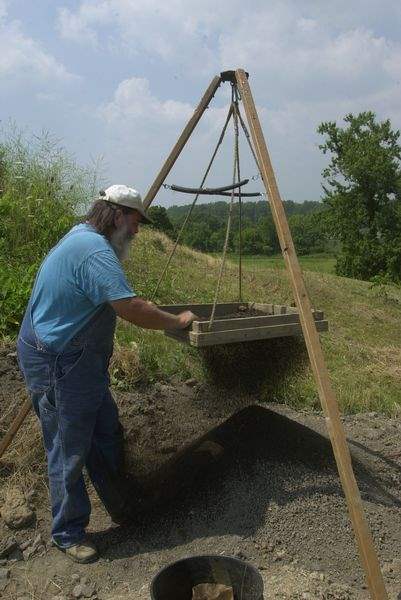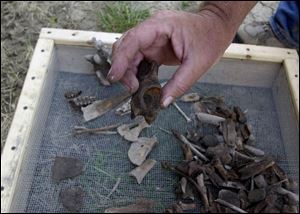
Fort Meigs renovation yields peek at the past
8/3/2001
`A good place to live is a good place to live. You can see why they picked this spot,' says Bill Pickard, an archaeologist with the Ohio Historical Society, sifting through the soil.
blade

`A good place to live is a good place to live. You can see why they picked this spot,' says Bill Pickard, an archaeologist with the Ohio Historical Society, sifting through the soil.
On a sun-baked hill along Fort Meigs' northern stockade, archaeologist Bill Pickard's fingers snake through cakes of dried mud, expertly plucking out pieces of prehistoric trash.
There are fish scales and deer remains, raccoon bones and possum teeth, arrowheads, and shards of ancient pottery.
Distinctive gray charcoal layers in the otherwise red and yellow clay mound confirm his suspicions: This is an ancient barbecue and dump site dating to about the 11th century.
Land along the Maumee River, he says, may have been just as much prime real estate a millenium ago as it is now.
“A good place to live is a good place to live,” he says, glancing up from his work in a sifting screen to the picturesque waterway nearby. “You can see why they picked this spot. And just like a lot of ravines today, you find places where people dumped their garbage.
“Some things don't change.”
The 1813 replica fort and state memorial in Perrysburg is undergoing renovations along its fence and blockhouses. This summer, construction crews, archaeologists, and volunteers have extricated hundreds of artifacts from the churned up earth, including the skeletons of two horses, apparently felled during one of two sieges on the fort.

Among the items discovered: pottery, animal bones, and other artifacts.
None of the artifacts, by themselves, are archaeologically significant, but their discovery has kept Mr. Pickard, an archaeologist for the Ohio Historical Society, at the site several weeks longer than expected.
They also have offered a peek into everyday life throughout the layers of local history.
Some of the first people here munched on fish and critters. Bones and shells abound.
The same animals often provided wardrobes. Prehistoric needles and animal bones used to scrape fat and flesh from fur were unearthed here.
And large, scary beasts were an everyday threat.
From a pile of artifacts collected earlier this week, Mr. Pickard flicks out a nearly inch-long piece of bone that includes what appears to be a claw from a bear “or some other animal I'd rather not get a hug from,” the archaeologist says.
This growing collection will be identified, sorted, and catalogued. The work is often confusing.
At least two volunteers, in fact, have told The Blade they picked up human bones at the site - findings that can not be immediately discounted, acknowledged both Mr. Pickard and site manager Larry Nelson.
Dr. Nelson said an intern found “four to five” bone fragments that could not be identified as nonhuman, including one that appeared to be a two-and-a-half inch fragment of a skull bone.
Scattered at the site, the pieces will be analyzed at an Ohio Historical Society lab, and archaeologists will decide what to do from there, Dr. Nelson said.